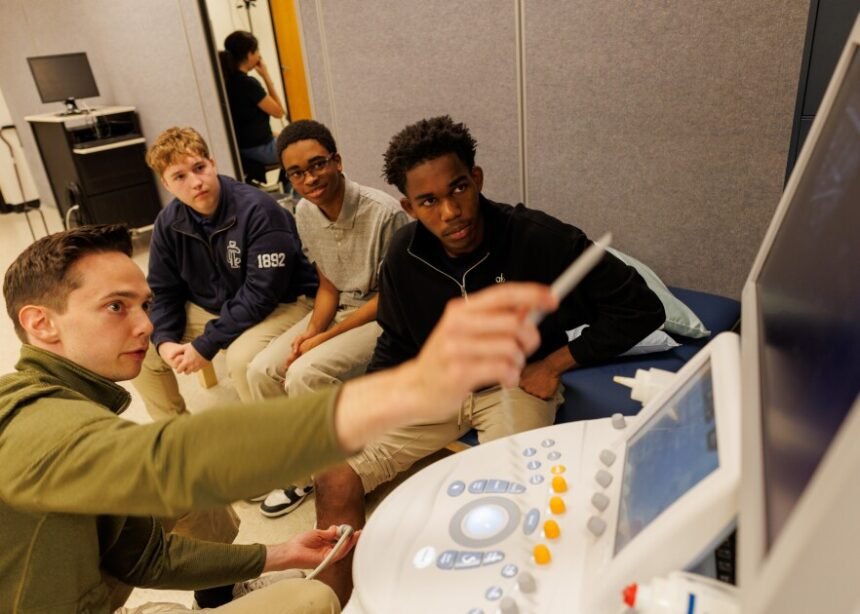Baltimore Polytechnic Institute juniors Isaiah Bell, Kyle Nicholson, and Milo Perrett spent a recent afternoon walking on trip-hazard treadmills, doing arm curls bedecked with motion sensors, and tracing their ligaments via ultrasound.
“They sang ‘Dancing Queen’ about me,” Milo, 16, quips as he steps and wriggles on a set of pressure plates, while motion sensors stuck to his clothing track the way his arms swing and joints bend.
“How does that correlate with what we saw on the treadmill?” Isaiah asks, pointing to equipment designed to measure muscle activity in lower limbs during a fall. Vicki Gray, an assistant professor in rehabilitation science at the University of Maryland, explains how physical therapists use the equipment to help stroke survivors recover their balance and movement.
The lab here at the University of Maryland’s medical school is part of its Research and Mentoring Program, or RAMP, a two-year career-exploration initiative for high schoolers intended to encourage young people to join health care and research fields.
All three boys say the program has driven their interest in becoming physical therapists, a field in which women outnumber men 2 to 1—and one they hadn’t previously pictured themselves pursuing.
“With this health stuff and the nurses stuff, we always think of girls first,” Isaiah said . “Maybe if you really put it out there for the boys to see, maybe they can catch an interest, too.”
Schools don’t do enough to expose and promote these pathways to boys, particularly if classes easily fill with girls, Milo said. He recalled peeking into a class on the medical track and seeing that it was mostly young women.
“It was interesting, because I hadn’t realized the imbalance,” he said.
Educators and policymakers are increasingly noticing the imbalance, too. Female-dominated health, education, and social services are among the fastest-growing career fields in the country, and all have experienced staffing shortages in recent years. Strengthening the pipeline of men into these fields could bolster those workforces and provide more personalized care and instruction for boys, experts say.
But doing so means countering students’ stereotypes about the role of men in care-oriented careers. And, amid stubborn pay gaps in woman-heavy professions, educators will need to help students define what career success in those fields means for them.
“We no longer live in a muscle-and-brawn economy; a lot of the economic opportunity does in fact exist in these intellectual and caring professions,” said Jeff Strohl, a research professor and director of the Georgetown University Center on Education and the Workforce. “There’s a lot of benefit there to having men get out of their old stereotypes of the manufacturing economy. … Giving back to society in a caring profession seems to be a good selling point—but traditionally, we sell it to women; we don’t sell it to men.”
In his 2022 book Of Boys and Men, Richard Reeves, the founder of the nonprofit American Institute for Boys and Men and a Brookings Institute senior fellow, argues that female-dominated or trending fields such as social work tend to get described as more “naturally” suitable to women, even if they have had more equal or male-dominated labor forces in the past.
Boys, he concludes, are less likely to be funneled toward socially oriented careers than their female peers, and studies find young men more likely to see female-dominated careers and even the skills associated with them—such as collaboration and communication—as inherently less masculine.

Preparing Students for What’s Next
The pathways to college, internships, and work have changed. What does that mean for secondary education? Explore the series.
That can make boys less competitive—and more resentful—in a changing workplace. National surveys find a majority of young men (including Gen Z) now believe that efforts to reduce workplace inequality for women systemically disadvantages men.
Young men’s participation in the labor force has declined steadily over the past two decades, and across every racial group, they also lag women in attending and completing college. Unemployment among young men (age 16-24) sits above 10%—still more than 2 percentage points higher than before the pandemic. Yet there are opportunities in the health, education, and social service fields.
“The new middle class jobs are in fields that are often labeled ‘pink collar.’ … They are more focused on people, rather than on things, and they tend to require more literacy than numeracy skills,” Reeves wrote. “If certain occupations are seen as no-go zones for men, their choices are constrained, just as much as for women in the reverse case.”
What’s behind the gender disparity in health care, education, and other fields?
Federal Perkins grants for career and technical education, the U.S. Department of Education’s largest investment in high schools amounting to some $1.4 billion annually, require secondary school programs to report on the number of students preparing for “non-traditional fields.” It defines those as any career in which one gender represents 25% or less of total employment.
Decades of federal, state, and private investment to close workplace gender gaps has increased the share of girls in male-dominated fields. In science, technology, engineering, and math, for example, the share of women rose from about 30% of the workforce in 2004 to 40% in 2019.
But there has been little investment or progress in bringing more men into female-dominated work during that time. Men’s share of health, education, and social services workforces has never topped 22% between 2004 and 2019—and it has declined since 2014.
“I think guys are more geared to things that are hands-on, not boring; that’s why they might be interested in sports careers, or construction and engineering,” said Kyle Nicholson, the 16-year-old RAMP participant. “People have a kind of narrow mind about how the medical field is, because they just go off of what’s on TV. [Schools] need to let people know there are a lot more options.”


Courtney Curtis, the principal of Herbert Hoover High School in Fresno, Calif., and a school leader of color, saw that lack of awareness firsthand. As part of his doctoral dissertation, Curtis studied how boys of color, and particularly Black boys, in the district viewed the teaching profession. The students reported few teachers who looked like them and few adults encouraging them to enter teaching.
“They called out that we as educators don’t often talk to them about the benefits of the job itself, and the difference and impact that you can make as a teacher,” Curtis said. “That was a real ‘a-ha’ moment for me and my staff.”
The findings shaped how Curtis decided to adapt Hoover High’s existing teacher-pathway program when he became principal in the 2024-25 school year. He extended the teacher pathway from two to four years, and the school now actively recruits boys of color for the teacher-training program through their churches, community centers, and in family visits in students’ native languages. Curtis said he and his staff also regularly point out and compliment students taking on teaching-related duties, like tutoring or directing younger students.
“If I pass a kid is standing at the door to help a teacher or walking another student, I’ll say, ‘Oh, I see a future teacher!’” Curtis said “We need to use language that builds boys up to see themselves in the role.”
In the 2025-26 school year, 18% of Hoover High’s original 11th-12th grade teacher program are boys, but that share has climbed to 30% for the incoming 9th grade cohort.
Representation matters, but so does pay
Efforts to broaden boys’ career options often focus on representation. Career-education programs in states like New York and Washington have developed profiles and videos of workers in nontraditional careers, such as male preschool teachers or nurses, for example.
And representation can be particularly important for boys of color. Christian Jovel-Arias, a 5th grade bilingual math teacher in the Dallas school district, grew up in a mostly white community in Long Island and said he considered teaching “a girly job” until his first Black male teacher in 5th grade.
”My mind was blown. I was so used to having a white female teacher; that was the archetype,” he said.
That teacher, Jovel-Arias said, “shifted my perspective on people who can be teachers and the power it holds for you being that teacher, especially being a person of color.”
Now, he makes a point to give leadership and peer-support opportunities to boys whom other teachers have seen as discipline problems and telling them, “You should be a teacher!’”
But when it comes to traditionally female careers, educators also “have to address the pay issue” for students, said Alisha Hyslop, the chief policy, research and content officer at the Association for Career and Technical Education.
So-called “pink collar” jobs tend to have lower salaries and fewer opportunities for advancement—even though men in female-dominated industries often make more money and progress faster.
Irene Espinoza, the executive director of the nonprofit Healthcare Pathway Advocates, which works with hospitals and schools in California’s Central Valley to introduce students to high-need health jobs, said focusing on preparation and pay first can turn boys off.
“When you ask a student, ‘What kind of job do you want?’—we’ve already lost them,” Espinosa said. “If we ask them to be doctors and say it takes 16 years of school, they’re out, done, end of conversation.”
Instead, Espinosa and other mentors in her group ask students about their interests and goals: A student who enjoys travel might be a fit for contract nursing, while another who takes care of younger siblings shows skills critical for an early-childhood educator.
“We start identifying how they want to live, and then we can have those conversations about the career to sustain that lifestyle,” Espinosa said. “They are highly motivated, so once we identify what that motivation is, they’re not as discouraged by the time that’s invested.”
Steve Eaton, a physical therapist and orthopedic researcher participating in RAMP, said his own high school sports injuries got him interested in biomechanics and pain. That helped him connect with Isaiah, a basketball player who experiences knee pain, and Milo, who said he was fascinated by medics treating football injuries at games. The boys have responded to him framing work through the lens of helping patients recover.
“Let’s say we think his muscle might be torn,” Eaton told Isaiah. “If I follow the muscle all the way along, think to yourself, … is it continuous? Is there a dark spot where the muscle is there and then it’s not? You can tell it falls pretty much all the way through. So we know the muscle is indeed intact.”
Isaiah, who attends Baltimore Polytechnic’s engineering track, said visits to this lab and a physical therapy clinic he visited with RAMP last summer have helped interest him in the field as a career.
“The thing about the physical therapy that I liked so much is, I was meeting different people and I was learning about their stories—what they did before or what they’re currently doing and how the physical therapy helped,” Isaiah said. “I’m not the type of person to sit at a computer all day. I like to move around and if somebody needs help, I’m working with somebody.”



Motivating boys into helping professions through service
In fact, actively helping people was a draw for all three boys visiting the physical therapy lab—which may be key to broadening the pipeline of boys to health, education, and social jobs generally.
The most effective approaches to getting boys interested in female-dominated careers, said Hyslop of ACTE, “focus on the impact that men can have in their communities.”
Organizations such as Scouting America and 4-H, which have historically introduced boys to service-oriented careers, have seen significant declines in members in the last decade. That makes for a heavier lift for educators.
“We in the United States have lost some of our focus on service to society,” said Strohl of Georgetown University. “That service commitment used to be part of the integration into work. Now kids turn more and more to how much money you’re going to be making. It’s a little difficult for the school counselors to make the pitch, ‘Don’t be a petroleum engineer with a starting pay of $130,000—no, go be a teaching assistant with a starting pay of $27,000.’”
Focusing on meaning and impact can help reframe career success for boys. For example, in one recent study of social work, in which men made up only 22% of the labor force in 2018, men were more likely to apply for a social work job that was framed in terms of challenges where men’s talents could make a difference.
In Baltimore, Milo Perrett said his experience in the RAMP program has changed his sense of the field. Before getting involved with the RAMP program, health careers seemed daunting.
“I was a little bit skeptical at first because I wasn’t totally into medicine. I didn’t know if it suited me; you kind of have to learn a lot and get a lot of schooling,” Milo said, “but coming in and seeing everybody and how they work and how diverse it is really brought me to the medical field. We worked with a lot of physical therapists and it was like, I want to do this. I like helping people.”







